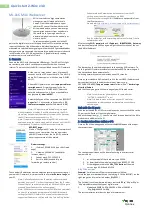
2
drive, states of the spare and new drives vary by the support of the storage controller for data
copyback:
If the storage controller supports copying data on the pooled spare drive back to the new
drive, the new drive becomes a RAID member drive and the pooled spare drive is placed in
standby status.
If the storage controller does not support copying data on the pooled spare drive back to
the new drive, the pooled spare drive becomes a RAID member drive and the new drive is
idle. You can configure the new drive as a hot spare drive from the management interface
or CLI.
Applicable scenarios
The hot spare drive feature is applicable to critical data storage scenarios with high security and
disaster recovery requirements, for example, unattended equipment rooms.
RAID rebuild
About RAID rebuild
RAID rebuild is required when a new drive or hot spare drive replaces a failed drive in a redundant
RAID.
Applicable scenarios
The RAID rebuild feature is applicable to scenarios where automatic RAID rebuild is required after
faulty drive replacement.
Copyback
About copyback
If a drive fails, the storage controller uses a hot spare drive to replace the failed drive and rebuilds
data of the failed drive on the hot spare drive. When the storage controller detects that a new drive
replaces the failed drive, it copies data on the hot spare drive back to the new drive and places the
hot spare drive in standby status.
Applicable scenarios
If a drive fails, a hot spare drive will automatically replace the failed drive in a RAID. If the
administrator uses a new drive to replace the failed drive, the administrator can set the new drive as
a hot spare drive, changing the slot for the hot spare drive. With copyback enabled on a storage
controller, the storage controller will copy data on the hot spare drive back to the new drive and
places the hot spare drive in standby status.
Copyback ensures that hot spare drives remain in fixed slots for easy location and management.
Copyback affects drive performance. As a best practice, perform copyback when the system I/O is
not busy.
Содержание UniServer E3200 G3
Страница 35: ...19 Figure 29 Selecting the RAID volume to be deleted...
Страница 116: ...56 Figure 96 Controller Configuration screen...
Страница 220: ...61 Figure 109 Selecting Main Menu 2 Select Controller Management and press Enter...
Страница 243: ...84 Figure 153 Confirming the operation...
Страница 293: ...50 Figure 89 Clearing completion...
Страница 382: ...21 Figure 27 Storage controller information...
Страница 389: ...7 Figure 8 Identifying a storage controller 2...











































